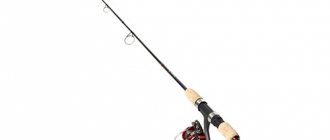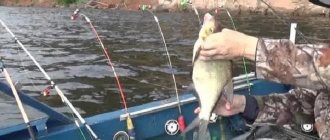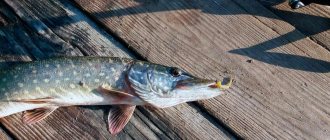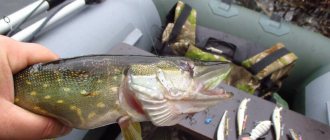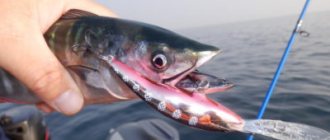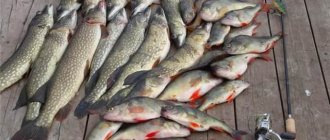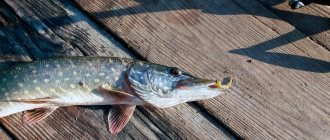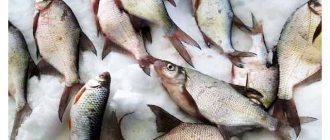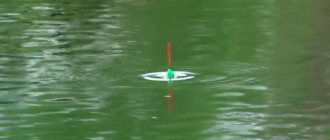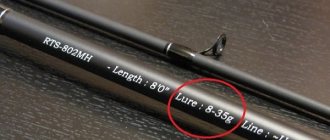Fishing with a spinning rod is undoubtedly one of the most difficult and energy-consuming fishing disciplines, requiring flexible thinking and active movements from the fisherman in anticipation of the long-awaited bite.
Spinning involves the use of artificial baits, so the angler’s task is to select the most natural and attractive game possible, to avoid suspicion from aquatic inhabitants and provoke them to attack.
To achieve success in spinning fishing, it is necessary to know what kind of fish bites on certain baits and what fishing to use for them, where on the reservoir the object of interest is located and when the most suitable conditions for fishing it are.
What kind of fish can you catch with a spinning rod?
It is important to know that the objects of fishing with this tackle are most often large fish. At least, most spinning anglers are focused specifically on catching serious trophies.
Even fans of the ultralight spinning rod, which is now gaining popularity, will not refuse to compete with an opponent whose weight is close to the upper limit of the permissible limit of this delicate tackle.
When going to a pond, a fisherman must take into account not only the size, but also the expected species composition of the fish for the upcoming catch. These factors mediate the spinner’s choice of the appropriate rod and lures. What kind of catch can you fish with a spinning rod?
In the rivers and lakes of our country, the objects of spinning fishing are mainly predatory fish:
- Pike;
- Perch;
- Zander;
- Bersh;
- Catfish;
- Burbot;
- Salmonids.
Conditionally predatory species are also caught using spinning rods. It is known that some representatives of the carp family, upon reaching adulthood, switch to feeding on young fish or from time to time dilute their diet with animal food:
- Asp;
- Chub;
- Ide.
Good to know! You can also catch peaceful fish with this tackle: rudd, crucian carp, carp, bream, provided you use small baits: microspinners, jigs, as well as silicone imitations of water insects and crustaceans.
Subtleties of spinning fishing
When fishing, it is important to choose a tactic to search for an active predator. Conventionally, two methods of searching for fish can be distinguished: active and passive. The active method involves constant movement in search of interesting areas where a predator can stay.
The passive method is characterized by fishing one or two promising areas with everything that is in the clip. Both tactics can bring success to the spinner if he knows where to look for the predator.
Where to fish?
In search of predator sites, the fisherman needs to navigate through concentrations of small fish, on the movements of which the predatory fish also depends. If small fish are splashing in shallow water, then the pike or perch will most likely stick to the edge of the dump, from where they rush at the prey.
Pike are effectively caught in areas with an abundance of edges, behind which it is convenient for it to hide, lying in wait for fish; near reed walls and at the edge of emergent vegetation; in snarled places; on dry patches and other uneven terrain.
Good to know! Perch, being a schooling fish, does not stand still for long, unlike pike. It can be found in absolutely any area of the reservoir, with the possible exception of riffles. Pike perch prefers holes with a snagged bottom, rocky ridges, from where at dusk it moves to the shallows in search of prey.
When to catch?
You can fish with a spinning rod throughout the open water season: from spring, as soon as the ice melts, until late autumn. The most fruitful time for spinning is when the fish are feeding.
There are several of these throughout the year: two in the spring – pre-spawning and post-spawning; one in autumn, when the fish actively feeds, fattening up fat for the winter.
There is no consensus regarding the most productive time of day for spinning. It is believed that pike actively bite in the first few hours after dawn, and also in the evening a couple of hours before sunset.
Note! However, pike outings, which are not easy to catch, often occur at lunchtime. Due to the unpredictability of its habits, perch should be expected at any time. And fishing for pike perch is most effective in twilight and at night.
Winter, big river, shore
In my opinion, the main way to solve the problem is quite simple. And in essence it is the same in most bodies of water, regardless of their size, geographical features, time of year and fishing methods. After all, in fact, the original source of the problems lies far beyond the technical side of the issue. I believe that the guarantor of success, first of all, is not the sophistication of technical means and methods of fishing, but the ability to correctly compare all the factors influencing the life of the fish, look into the essence of the problem, understand it and develop the right strategy.
Simply put, when faced with a lack of bite at your favorite “spot”, you should not plunge headlong into experimenting with baits, changing them every 5 minutes to more and more sophisticated ones with a poisonous color and smell. First of all, you need to imagine the state of affairs in the underwater world and, taking into account weather, seasonal and other factors, draw the right conclusions and develop the most effective plan of action. And after that, you can look for technical solution options, of which there can be a lot, depending on the conditions in which you fish. And since we are talking about winter spinning fishing, let’s not forget that the water level in reservoirs suitable for such fishing is much lower than in summer. Based on this, it is clear that fish concentrate in the deepest places.
But this does not mean that you should always wait for a bite in the deepest place. Depending on meteorological and other conditions, fish can be active anywhere, both in the hole and at the exit from it, on nearby riffles or on shallow coastal reaches with small snags, which also depends on the breed of predator you are hunting. Do not forget that even though the water in non-freezing reservoirs is warm, it is still winter outside, and the fish are in a completely different mood. The reduction in daylight hours signals the transition to winter time. The fish becomes more passive, beginning to balance its nutritional needs with the amount of energy it will spend when rushing for “nimble” and not very necessary prey.
Therefore, when choosing a bait, more attention should be paid not to the color and smell, but rather to the wiring, weight, size, and frequency of its vibrations. Of course, when we talk about baits, we mean jigs. In those places where predator “exits” can be expected, heavier primates will work with active play. If there are no bites at a point where mass feeding is possible, it is worth looking for fish in those places where it remains most of the time in a semi-passive state. Such places are characterized by greater depths and moderate currents and are, as a rule, located near the “exit” points. Here it would be appropriate to use a slower retrieve and reduce the weight of the bait.
What to give preference to - searching for an active predator in those places where it goes out to feed, or trying to tempt fish that are in a semi-passive state to bite - it is not easy to answer. Often, in order to achieve success, you have to alternate between both. In any case, each time you need to not just monotonously throw the bait into the place you like, but be aware of what this place is like, and in each case try to analyze why the predator does not bite here, and where it is at this time catching is more realistic. Based not only on my observations, I would like to summarize. In my opinion, the panacea for lack of bite, first of all, is a conscious approach to fishing. In other words, a reasonable search for an active predator, supported by real knowledge, experience, and skill.
Choosing bait when fishing with a spinning rod
The modern fishing market has a huge selection of baits for catching freshwater inhabitants of our waters with a spinning rod. When buying lures, it is important for a beginner to understand what he expects from this gear, what kind of fish he is going to catch, in what conditions and with what spinning rod. With proper attention to these points, the fisherman develops a taste for selecting lures.
He will know that when pinching fish to a “ringing”, ultra-fast action form, it is advisable to use jig baits. For a rod that is short up to 210 centimeters and has sufficient rigidity, the fisherman will take wobblers to the pond, the persistent movement of which can be handled by such a spinning rod.
An inquisitive fisherman knows that when fishing in snags or in shallow water, poppers, walkers and other surface baits will help out, and on a bottom richly overgrown with algae and in rocky areas, it is preferable to use all kinds of non-snagging baits.
Good to know! If a spinning angler wants to try his hand at hunting for asp, he will add castmasters and Devons to his arsenal, and to catch chub he will purchase small wobblers and spinners. In short, each fish has its own range of favorite baits. The most common trophies for spinning rods are pike, perch and pike perch, so further we will talk about the baits preferred by these predators.
For pike
- Classic spinners are concave spinners that perform oscillations of varying degrees of intensity in the water, which depends on the constitution of the spinner’s body and the reeling speed. They perform well on pike during the autumn feeding period of this predator.
- Castmasters are heavy and long-range spinners of a specific shape, showing a measured, medium-intensity game, convincingly resembling a wounded fish.
- Asymmetrical spinners are spinners with a shifted center of gravity to the lower part of the body, characterized by sweeping, yaw movements when retrieved.
- Rotating spoons or spinners are spoons with a petal rotating around a metal axis. The spinner comes into action with water resistance, therefore, the faster the speed of the retrieve, the more often the petal rotates. They catch decent pike on spinners number 3 to 5.
- Wobblers are artificial fish made of plastic or wood, differing in body height, size and angle of inclination of the nasal blade. Wobblers with a small blade relative to their length are suitable for catching pike by twitching, and fish with a wide and long blade, capable of diving to great depths, are used in trolling fishing.
- Poppers are bladeless surface baits that, due to a recess in the nose, produce gurgling sounds when pulled with a blank. Ideal for fishing for pike in snags.
- Silicone fish: these include twisters, which have a long and wide arched tail; vibrating tails - an imitation of a fish with a hoof-shaped tail actively wagging in the water; and “edibles” - silicone nozzles soaked in salt and flavorings. The common size of silicone when fishing for pike is 5-12 cm.
For perch
Perch can bite on all the same baits as pike, only their size should be much smaller.
If you try to rank the preferences of perch, the first three places will be taken by:
- turntables number 3;
- silicone baits up to 5 cm long;
- micro-oscillators weighing 2-6 grams.
Of the silicone baits in perch fishing, edible rubber has proven itself to be the best. Manufacturers often create “edibles” in the image of aquatic larvae and crustaceans that perch feed on.
It must be remembered that most of these imitations do not have a pronounced game when fishing, so it is the fisherman’s task to animate them with the tip of the rod. Dragging a silicone crustacean along the bottom, from which the perch picks up food, can be effective.
Recently, the method of catching perch using a retractable leash has gained popularity. This method is indispensable when fishing on difficult terrain. Attaching an end sinker to the main line and mounting it 20-30 centimeters from the weight of a leash up to a meter long with a twister or spinner at the end allows the fisherman to fully control the course of the bait in the bottom layer.
For zander
The list of catchable baits for pike perch is much narrower than that of the above-mentioned predators. This does not mean at all that pike perch will not show interest in a wobbler or spinner, but the main element of pike perch is jig bait:
- Twisters
- Vibrotails;
- Foam fish.
When fishing for pike perch, oscillating spinners are the best catchers, and above all, narrow spinners of the driven type, reminiscent of a minnow or bleak.
INITIAL SELECTION ERROR
Note In the picture, the Offsetnik is not the most powerful, but for a pike of this size this is not so important
Situation one. The Ruza River near its confluence with the Ruza Reservoir. Spring, temperature around zero degrees. We recently fished on this river, literally a week ago. I can’t say that they were caught very well. I only caught three small pike. But the fabulous forest, the beautiful river, the majestic spruce trees hanging right above the water, irreversibly pulled me back. I really wanted to plunge into this beauty again. Which actually brought us to the appointed place after just 6-7 days. The river was unrecognizable. Of course, nature remained in its original form, but what was happening to the river is difficult to convey in a calm tone. The water level has risen by one and a half meters, but previously it was possible to cross it almost everywhere in waders.
But... what happened before can never be returned, maybe it looks like it in appearance, but... it’s not like that. The temperature did not rise above +2 all week, so it was too early to think about the onset of a heavy flood. We expected that the water would become cloudy, but no one could have predicted that its level would change so much. And the solution lay right on the surface. The Ruza River flows from the Verkhneruzsky Reservoir; accordingly, its level also depends on the discharge from the dam. No one had foreseen this, so the picture of the river put all members of the trip into a slight state of shock. Another important miscalculation is that no one thought about an escape option; to tell the truth, it wasn’t even around. ...it took about 140 km to move to another body of water... Now, especially in the spring, I am very cautious about this kind of adventure. Somehow, I no longer have the desire to overcome 170 km by playing Russian roulette.
Situation two. Twentieth of July, Ruza Reservoir, Ostashevo village. According to reconnaissance data, having arrived here, it was possible to catch a good perch, and from time to time a medium-sized pike was caught. Before this, the weather was quite bearable, there was no strong wind, the sun was shining. But... the law of meanness, when you are just getting ready to go fishing, warm yourself with warm thoughts about the upcoming vacation, the weather is beautiful outside the window. As soon as you get out, having moved and abandoned things to far away, clouds appear from somewhere, the wind intensifies. This trip was exactly like that.
The first half of the day we swam around familiar spots, fought against the elements and our inner voice, without really catching anything, except for the heels of the fish. The idea that it was time to get away from such a helicopter came to mind while still on the shore, but they decided to implement it only towards lunch. The reason for this is an hour-long rowing against a decent wind to the nearest (based on the experience of past years) working bay. We still managed to gather our strength, and here we are. Everything is quiet and calm, there is practically no wind. As a result, in the remaining four hours, about fifty perch were caught between the two of us. This was my first experience when the wind so clearly changed the location of perch schools.
If we had taken this into account earlier, we could have avoided wasting half a day fighting the wind, but simply be patient for an hour, swim to the right place and fish calmly during the day. And this is what happened: before this there was no strong heat yet, the perch stayed in places more warmed by the sun. But a sudden change in the weather forced him to leave his previously inhabited places. The wind drove a decent wave, which mixed the warm upper layers with the cold, lower ones. Active perch remained only where something prevented the wave from gaining full strength - either under a quiet shore, or in shallow bays closed by forest. This was the very fundamental case, after which I pay very close attention to the wind, the sun, comparing this with the time of year and previous weather. And believe me, after this there were much fewer errors of this kind, and if any were present, they were corrected much faster - as soon as the alternative options were checked, the correct solution was found.
Maxim Balachevtsev
With today's widespread enthusiasm for ultralight, many spinning anglers are trying to lighten their gear when fishing for pike in the grass. And then they find themselves in a bad situation: they have to constantly swim to the hooks, thereby scaring the fish; Fishing does not work, since the low power of the tackle allows the pike to dive under the carpet of grass.
Vladimir Gabelev
As you know... the fish bite where we are not. Therefore... you need to move not where you want, but in exactly the opposite direction! Especially if someone there already often catches fish and uses a landing net.
Features of spinning wires
Although there is a wide variety of spinning retrieves, they come down to three main techniques used for specific baits:
- Uniform wiring . It is best for a beginner to start mastering spinning with this technique, since this technique does not require animating the bait. The result is often brought by manipulations with the wiring speed. Uniform wiring is necessary when fishing with rotating spoons, otherwise the spoon simply will not play in a natural way. A uniform stroke is promising for oscillating spoons, less often wobblers and jig baits.
- Jerk wiring.
There are two main types of jerk wiring:
- Twitching is a technique for inserting wobblers and poppers, which involves short pulls with the tip of the rod followed by reeling. When twitching, the wobbler, sharply colliding with the resistance of the water with its blade, makes an outgoing jerk to the side, and when pulled, the popper produces gurgling and splashing on the water surface.
- Jerking is a method used to fish with jerkbaits - large baits belonging to the class of wobblers, but unlike a classic wobbler, they do not have a blade. When jerking, the bait is pulled with fairly powerful jerks and twitches. At this moment, the jerkbait accelerates, continuing to play in the water during the pause by inertia.
- Stepped wiring . As a rule, it is used for jig baits - twisters, vibrotails, foam fish - and much less often for oscillating spinners. Stepwise wiring is carried out in the bottom layers of water. This method is characterized by alternating windings and pauses. As a result, the bait either rises above the bottom or falls back to it. The performance of the bait depends on the number of turns of the reel and the length of the pause.
With three or more revolutions, the twister takes wide steps, and with fewer revolutions and a minimum pause, the artificial fish makes frequent jumps. The latter method is promising if the predator is passive and can only be provoked to bite by constantly flashing the bait before its eyes.
The importance of bait wiring
Over time, I began to understand some of the secrets of spinning, that I just don’t know how to fish with them yet, I haven’t grown up to them yet. The master’s specific fishing idea embedded in a specific bait did not reach me. His very clear understanding of how to catch fish in certain conditions. His opinion is not only on the size, shape, color, nature of the vibrations of the bait, but also, most importantly, what kind of wiring to use it with! There's a dog buried in the wiring! If it is not picked up, then the fish is not caught .
It is also not caught when the bait is used in inappropriate conditions - at a different depth, current strength, degree of illumination, etc.
These points are clearly visible when fishing with homemade wobblers, which are sculpted by our experienced spinners. If they make simple wobblers and let their comrades test them, they will immediately begin to drag fish. And when they trick something twitching, which must go on specific tacks, with a certain strength and amplitude of the jerk, then this wobbler can catch great only from the owner himself. Unless the master tells you and shows you how and where to fish with this particular bait.
Something similar with the “Japanese”. Many of these baits brought to us are made for the domestic Japanese market and are not accompanied by any instructions in either Russian or English, and difficulties arise in “deciphering” the essence of the bait. You have to figure everything out by trial and error. Sometimes, literally on the first fishing trip, the fish are caught right off the bat. Sometimes a wobbler remains unidentified for years, so to speak, uncaught. It turns out that when mastering complex wobblers we are in a deliberately difficult position. After all, in addition to the lack of instructions, you also have to adapt the bait to a different fish for which the wobbler was designed by the developer. But if the key is found, then a trout wobbler is great for catching chub or perch, and a bass wobbler is great for catching pike. And this has its big advantages, when you learn everything yourself, not according to instructions, this is simply incredible interest.
You have to work a lot with each bait . Despite their external similarity, the same minnows with the same wiring behave radically differently. During a jerk, one wobbler will minimally deviate from the main movement of the wiring, the other is developed much wider or after each jerk it turns almost 180 degrees, and even jerks a little in the opposite direction. Different wobblers have a lot of game options built into the design. And not much less for one model with different wiring. At the same time, it is problematic to find some kind of universal wobbler that works stably in the same area of the reservoir. After all, the mood of a predator can be very changeable.
Today the pike is angry, aggressive and takes much better on an actively working wobbler, and this activity is equally important both in my work with the bait and in the game built into the design. And the next day there is no pike, and a passive bait and the same sluggish wiring will work much better. But these are just two options, which also do not become universal, because the sequence of jerks and the size of pauses also matter. Only by adding everything up will we see the result: whether we catch it or not. If so, how many or what size pike.
With perch it's even more difficult . In my opinion, perch fishing is more difficult than pike fishing, and just as interesting. For example, if a pike almost always reacts well to the simplest game, when the bait goes in a zigzag to the right, then to the left, then give the perch something more complicated. There is some kind of chaos in the movements, and in it you have to find a system in order to repeat it in the future. And what’s interesting is that single perch is the easiest to catch. In a small flock, the striped one begins to be picky, but when surrounded by a large number of brothers it can become seriously capricious. Knocks on the bait, often chases, but does not attack. But only until I select a wobbler with suitable wiring, and then, without leaving the spot, I can really catch as many perches as I want. This is really true, and not at all empty chatter, that a twitching wobbler sometimes catches striped fish much better than rubber and spinners. But not always and everywhere. According to my observations, the same small rubber on a micro jig or lead leads works more consistently. So why then this twitching, these expensive wobblers? Yes, because it is difficult, beautiful, and therefore interesting! It is these non-obvious subtleties in the choice of wobbler and wiring that are interesting. Everything else in the twitching gear, by and large, does not matter - whoever is comfortable with what. Here, by the way, there is an observation that concerns almost any direction of spinning: “interesting complexity” is present only in one part of the fishing, otherwise the result will be a vinaigrette.
Jig is a typical example, and the direct opposite of wobbler twitching . Why was the jig mastered so quickly? Yes, because technically this is a fairly simple way to catch a predator, just like a feeder when catching leucorrhoea. There are no halftones, adjectives or interjections in the jig. There is a clear, bare geometry of the bottom step, which you can show even on your fingers, and you will catch it. I don’t want to say that the jig is “dumb”, no, I often practice it with pleasure, but it is simple. Even in baits. I don’t see the point in selecting some special ones that will work much better than others. Disputes on this matter, in my opinion, come down to unimportant things: foam rubber or rubber, twister or ripper, “Cheburashka” or jig head, bare hook or offset, large elastic band or small, white or green. Yes, and these disputes are sluggish, because it is good to catch both this way and that, you quickly find your favorite one, which is more believed in.
I don’t see any reserves in search of interest in the choice of braid and reel - everything has been worked out for a long time, it is present in the model range of many companies that do not go atrociously with price tags.
Tips for beginner spinners
- Carefully approach the choice of spinning rod, reel and fishing line, so that by connecting everything together, you get sensitive gear, because fishing is not only the opportunity to catch, but also the joy of the process.
- Always start with the simplest - coastal fishing, oscillating spoons and uniform wiring, gradually moving on to the development of new horizons.
- Use titanium or fluorocarbon leaders to prevent toothy predators from biting the line.
- To enjoy fishing, equip silicone fish with an offset hook that prevents snags on snags and grass.
- Don’t forget to adjust the reel’s drag to skillfully speed up the landing of fish.
Good to know! At first, lashing a spoon through the water can be tiring and seem like a pointless task, but only until the first blow of a predator hits the hand through the form. After this, the person with the spinning rod becomes a spinning player whose efforts will be rewarded.
